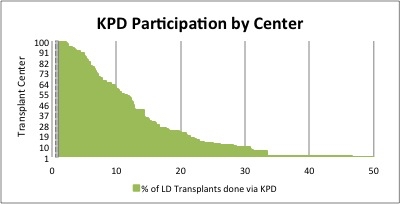Kidney Paired Donation: National Activity and Perspectives
1Surgery, University of Minnesota, Minneapolis, MN
2Surgery, Rush University Medical Center, Chicago, IL
3Surgery, Scripps Health, La Jolla, CA
4Surgery, University of Pennsylvania, Philadelphia, PA.
Meeting: 2015 American Transplant Congress
Abstract number: B172
Keywords: Donation, Highly-sensitized, Histocompatibility, Kidney transplantation
Session Information
Session Name: Poster Session B: Living Donor Issues 1
Session Type: Poster Session
Date: Sunday, May 3, 2015
Session Time: 5:30pm-6:30pm
 Presentation Time: 5:30pm-6:30pm
Presentation Time: 5:30pm-6:30pm
Location: Exhibit Hall E
While utilization of Kidney Paired Donation (KPD) continues to increase, the potential is not fully realized. We surveyed kidney transplant (KTX) professionals to evaluate perceptions of barriers and solutions to increasing KPD and correlated the results with KPD utilization patterns and center volume.
Methods: Transplant directors (medical,surgical,HLA), coordinators and administrators from all US KTX programs were invited to complete a 31 question survey. Center specific data was obtained from UNOS.
Results: While only 100 of 225(44%) centers participated in KPD in 2013, 22 centers performed 20-50% of their living donor (LD) KTXs via KPD(Figure 1).

Figure 1
Survey respondents(N=199) represented 129 centers(57%). 161/199(81%) of respondents were from centers participating in KPD; representing 10/11(91%) of centers performing >100/yr LD KTX, 23/31(74%) performing >50/yr, and 36/87(41%) performing <10/yr. Overall, 55% of respondents felt that their center 'probably' or 'definitely' underutilized KPD. 88/161(55%) indicated their program participated in more than 1 KPD program. Center KPD volume correlated with the practice of inviting all pairs to participate (p=0.04). Surgeons were most commonly cited as leading their center's KPD program(34%), with just 16% led by committee. Only 33% said their program dedicated ≥1 FTE to KPD. Lack of patient interest was most often selected as the '#1 barrier'. The '#1 solution' selected was the need to optimize one KPD program(27.4%), followed closely by decreasing financial risk(23.7%) and increasing patient education(21.5%).
Conclusion: Utilization of KPD is still limited, with non-involvement of >50% of centers. However, some centers routinely utilized KPD. By increasing patient education, unifying KPD programs, and controlling financial risk, there is the potential to significantly increase LD KTX activity.
To cite this abstract in AMA style:
Dunn T, Fayek S, Marsh C, Abt P. Kidney Paired Donation: National Activity and Perspectives [abstract]. Am J Transplant. 2015; 15 (suppl 3). https://atcmeetingabstracts.com/abstract/kidney-paired-donation-national-activity-and-perspectives/. Accessed December 14, 2025.« Back to 2015 American Transplant Congress
